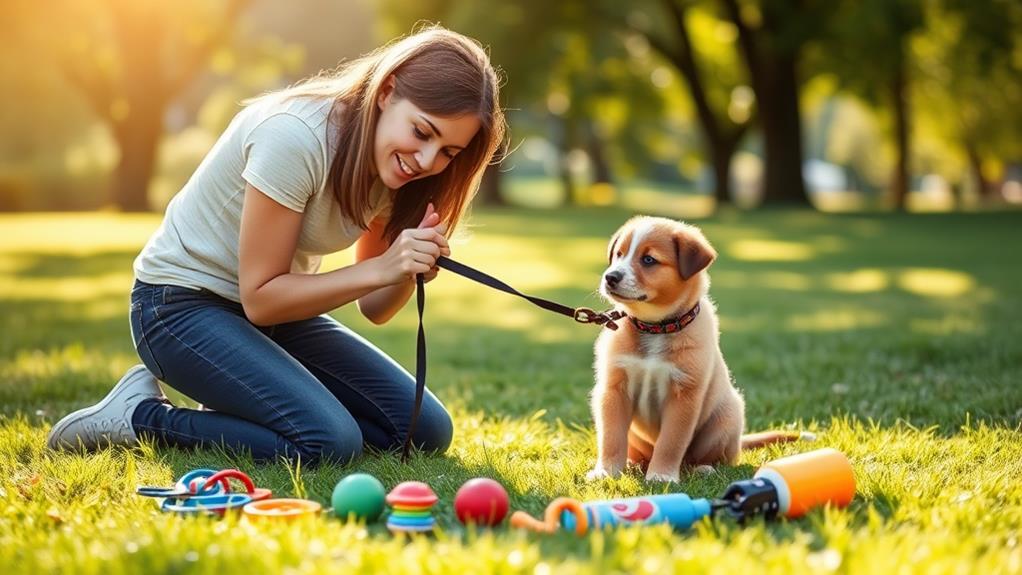If you're a novice dog handler, focusing on essential tips can make training easier and more effective. Start by understanding your dog's behavior; observe their body language and vocalizations. Use basic commands like sit, stay, and come consistently, rewarding desired actions with treats or praise. Employ positive reinforcement to strengthen learning and build trust through patience. Socialize your dog to reduce anxiety and foster confidence. It's important to stay calm during training and set realistic goals. There's so much more you can discover to enhance your skills and enrich your dog's training experience.
Understanding Dog Behavior

Understanding your dog's behavior is essential for effective training. When you observe your dog, you're not just seeing their actions, but also their emotions and instincts. Dogs communicate through body language, vocalizations, and even facial expressions. Pay attention to how they wag their tail, the position of their ears, and their overall posture. These signals can indicate excitement, fear, or aggression.
Recognizing the context of your dog's behavior is pivotal. For instance, if your dog barks at strangers, it might be a protective instinct, while a wagging tail could mean they're happy to see you. Understanding these nuances helps you respond appropriately.
Also, consider their past experiences. A dog with a history of neglect may be more anxious and need extra reassurance during training. Patience is key; building trust takes time, and it's indispensable not to rush the process.
Lastly, every dog is unique. What works for one mightn't work for another. By tuning into your dog's individual behavior, you'll create a more effective training plan that fosters a stronger bond between you and your furry friend.
Basic Training Commands
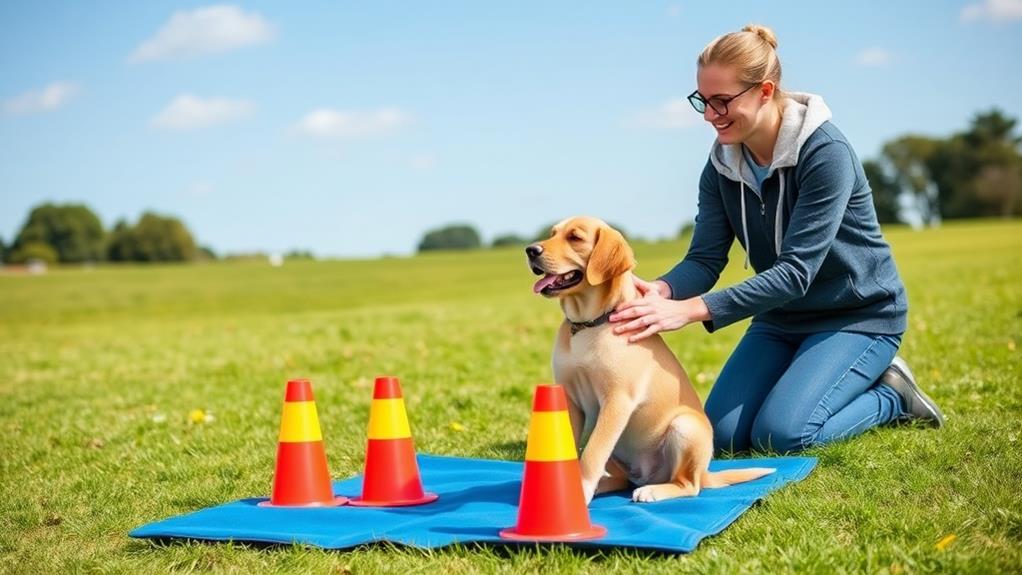
Mastering basic training commands is paramount for any novice handler looking to establish a strong foundation with their dog. These commands help you communicate effectively and build a bond with your furry friend.
Start by focusing on a few essential commands that every dog should know. Consistency in training will make these commands second nature for your dog.
- Sit: A fundamental command that helps gain control in various situations.
- Stay: Encourages your dog to remain in place, promoting patience and focus.
- Come: Crucial for safety, this command ensures your dog returns to you when called.
- Down: A calming command that encourages your dog to rest and settle.
- Leave It: Teaches your dog to ignore distractions, which is indispensable for their safety.
Practice these commands regularly in short, focused sessions. Remember to use positive reinforcement like treats or praise to encourage your dog's progress. With patience and commitment, you'll see improvement, and your dog will respond confidently to these basic commands.
Consistency Is Key
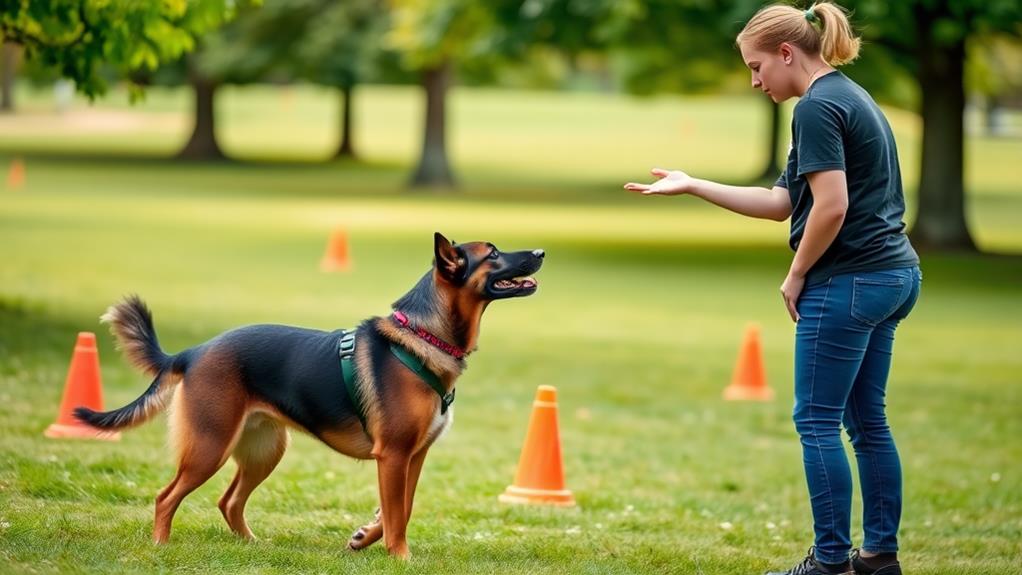
When it comes to dog training, consistency truly makes all the difference. Your dog thrives on routine, and establishing clear, consistent commands helps them understand what you expect. If you use different words or gestures for the same command, it'll confuse your pup. Stick to one phrase for each command and use it every time you train.
You should also be consistent with your reactions. If your dog performs a command correctly, reward them every time. If you only reward them sometimes, they won't know if they did something right or wrong. Consistency in rewards reinforces good behavior, making it easier for your dog to learn.
In addition, consistency should extend to everyone interacting with your dog. If your family members use different commands or are inconsistent in their responses, it can create mixed signals. Make sure everyone is on the same page about the rules and commands.
Lastly, be consistent with your training schedule. Regular practice will help reinforce what your dog learns. Short, frequent sessions are more effective than long, infrequent ones. By keeping your training consistent, you'll set your dog up for success and build a strong bond between you both.
Positive Reinforcement Techniques
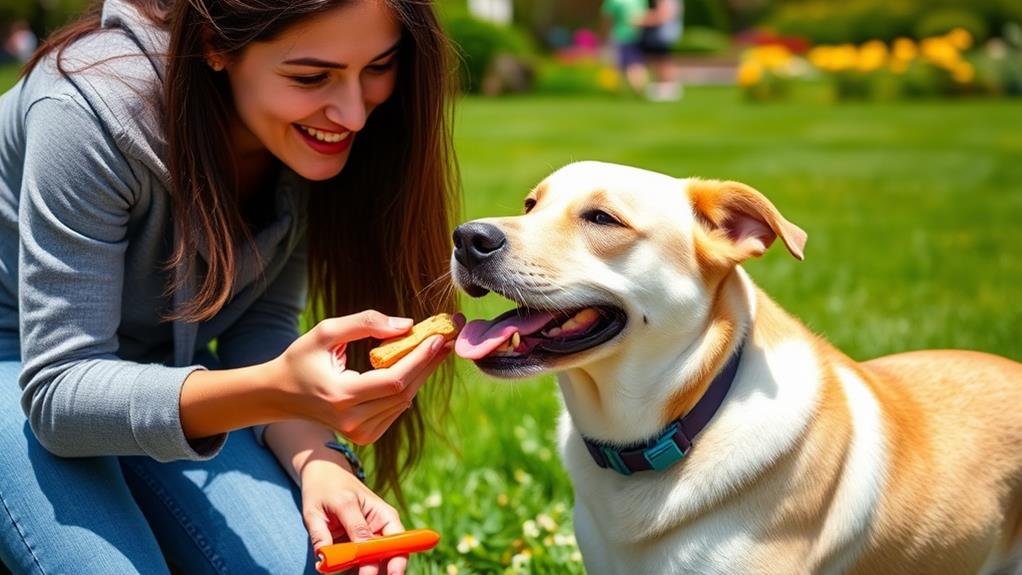
Building on the importance of consistency, positive reinforcement techniques play an essential role in effective dog training. These methods encourage your dog to repeat desired behaviors by rewarding them immediately after they perform correctly. This creates a strong association between the behavior and the reward, making learning more enjoyable for your dog.
Some key positive reinforcement techniques to think about:
- Treats: Use small, tasty treats your dog loves to reinforce good behavior.
- Praise: Verbal encouragement and affectionate petting can motivate your dog to keep up the good work.
- Toys: Some dogs respond well to playtime as a reward. Use their favorite toy to celebrate successes.
- Clicker Training: A clicker can help mark the exact moment your dog performs the desired action, making the reward more effective.
- Consistency in Rewards: Always reward the desired behavior immediately so your dog understands what action earned the praise or treat.
Socialization Importance
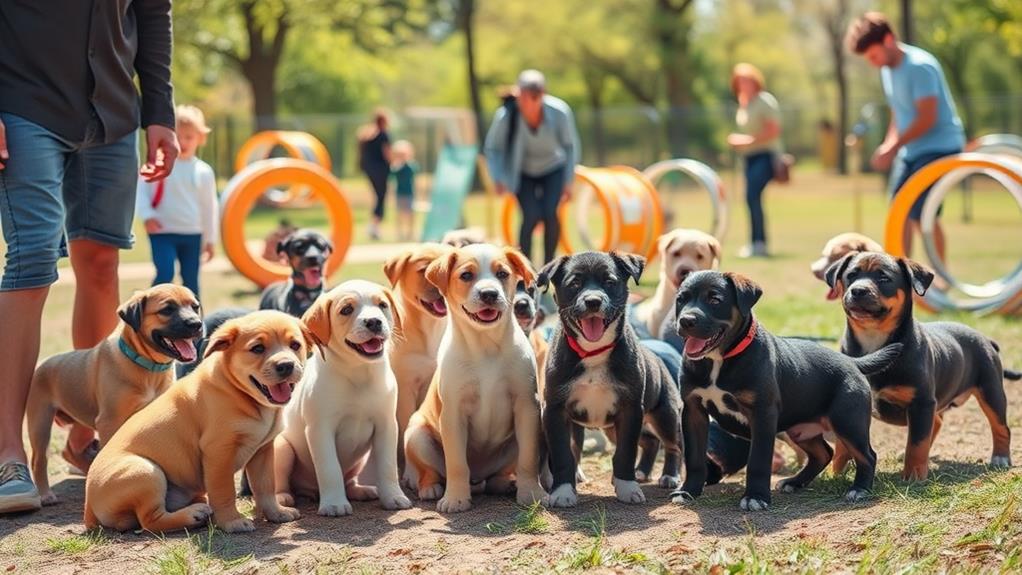
Socialization is essential for your dog's development and well-being. It helps your pup become a confident, well-adjusted adult who can handle new experiences without fear. Early socialization exposes your dog to various people, environments, and other animals, which can markedly reduce behavioral issues later on.
To help you understand the key benefits of socialization, here's a quick overview:
| Benefits | Description |
|---|---|
| Reduces Anxiety | Socialized dogs are less likely to fear new situations. |
| Encourages Good Behavior | Exposure to diverse environments promotes calmness. |
| Improves Communication | Dogs learn to read social cues from other dogs. |
| Builds Confidence | Positive experiences create a self-assured pet. |
| Fosters Friendly Attitude | Well-socialized dogs are generally friendlier. |
Handling Common Challenges
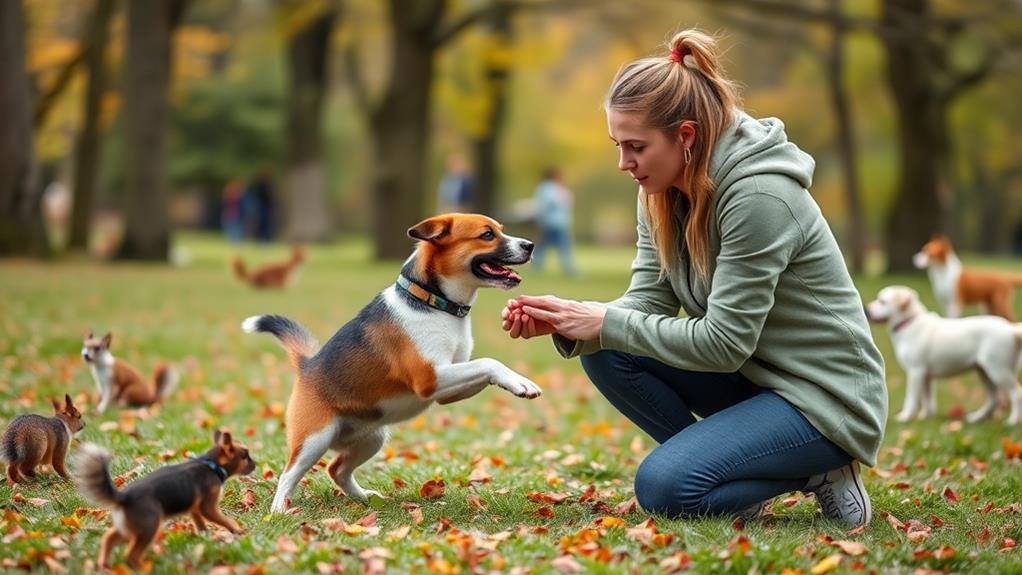
Maneuvering the challenges of dog training can feel overwhelming at times, but with the right strategies, you can tackle common issues head-on.
Consistency is key: Use the same commands and signals every time so your dog understands what you expect.
Positive reinforcement: Reward your dog with treats or praise for good behavior, encouraging them to repeat it.
Stay calm and patient: Your dog can sense your emotions. If you're frustrated, take a break and try again later.
Set realistic goals: Break down training into small, manageable steps. Celebrate the little victories along the way.
Practice regularly: Incorporate training into your daily routine. Short, frequent sessions are often more effective than long ones.
Resources for Further Learning
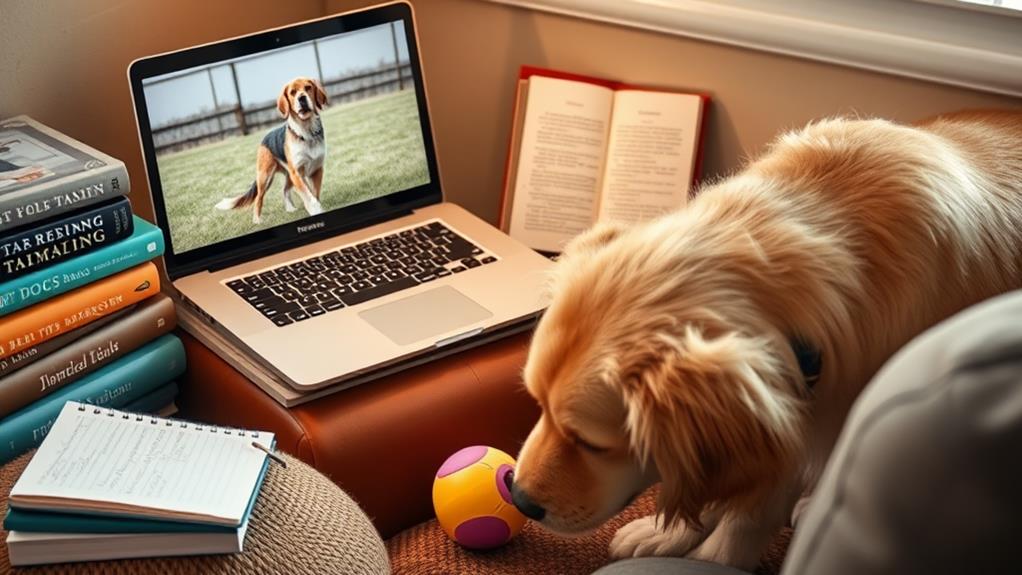
How can you enhance your dog training skills beyond the basics? To take your training to the next level, tap into a variety of resources designed for novice handlers like you. Books are a fantastic starting point; consider classics like "The Culture Clash" by Jean Donaldson or "Don't Shoot the Dog!" by Karen Pryor. These texts offer valuable insights into canine behavior and effective training techniques.
Online courses can also be a game-changer. Websites like Udemy and Coursera offer structured learning paths that fit your schedule. Look for courses taught by experienced trainers who focus on positive reinforcement methods.
Additionally, don't underestimate the power of community. Join local dog training clubs or online forums where you can connect with other dog owners. Sharing experiences and tips can provide you with new perspectives.
YouTube is another great resource. Channels dedicated to dog training often showcase practical demonstrations you can replicate at home.
Frequently Asked Questions
How Do I Choose the Right Training Equipment for My Dog?
Choosing the right training equipment involves considering your dog's size, temperament, and training goals. Look for collars, leashes, and harnesses that fit comfortably, and don't hesitate to ask professionals for recommendations that suit your needs.
What Age Is Best to Start Training My Puppy?
Starting training your puppy is like planting a seed; the earlier you do it, the stronger the roots. Ideally, you should begin around eight weeks old to cultivate good behavior and social skills effectively.
Can I Train My Dog Without Professional Help?
Yes, you can train your dog without professional help! With patience, consistency, and the right resources, you'll build a strong bond while teaching essential commands. Just stay positive, and your dog will respond well.
How Much Time Should I Dedicate to Daily Training Sessions?
Think of training sessions as seeds; the more you nurture them, the better they grow. Dedicate at least 15-30 minutes daily for effective training, ensuring consistency and solidifying your bond with your furry friend.
What Should I Do if My Dog Is Afraid of Training?
If your dog's afraid of training, start with short, positive sessions. Use treats and praise to create a fun environment. Gradually introduce commands, ensuring your dog feels safe and comfortable, building their confidence over time.
Conclusion
As you embark upon this journey with your furry friend, imagine the joy of watching them thrive, wagging their tail and eagerly responding to your commands. With patience and practice, you'll transform challenges into cherished moments, like a sunny day at the park filled with laughter and play. Remember, every small victory strengthens your bond, turning your training sessions into delightful adventures. Embrace the process, and together, you'll create a harmonious relationship that lasts a lifetime.

